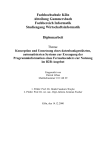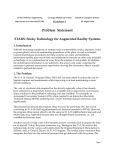Download SPV User Manual and Quick Start Guide
Transcript
SPV User Manual and Quick Start Guide Kaile Su, Yinyin Xiao, Weiya Yue and Qingliang Chen Department of Computer Science, Sun Yat-sen University Guangzhou, P.R. China January 18, 2007 SPV Version 3.8.2, January 2007 Welcome to SPV: a Security Protocol Verifier SPV is a robust software package used primarily for automatic verification of complex security protocols with an unbounded number of sessions. In detail, the function of SPV is the following: GIVEN: Input a formal description of a particular protocol and some security properties, which are to be verified. RESULT: Output whether the properties are satisfied by the protocol, the number of variables and constrains generated in the verification process, and the run time of the process. SPV is the implementation of Logic of Local Sessions (LLS), which is a new protocol logic based on a quite natural semantic model called Instantiation Space. The advantages of SPV are as follows: l SPV can deal with complex message formats with arbitrarily nested encryptions by public, private, shared and hash keys as well as freshly generated keys, due to the flexibility of LLS. l SPV can be used to verify complex security properties such as ‘Alice observes (knows) Bob observes (knows) Alice said something’, and the SECRET and PRECEDES in CAPSL. l SPV has been applied to automatically verify a lot of interesting and important properties for quite complex security protocols like Kerberos V5 and the SET protocol. For example, for the complex SET purchase phase protocol, SPV takes only several hours to generate eighty thousand rules and then verify many concerned specifications in several seconds. l SPV is very easy to be used. For example, the input language of SPV is just the actual definitions of the protocols and is user-friendly since it has more intimacy to its original forms. Moreover, users can define macros by themselves, which simplifies the input process for big protocols. l SPV is a fully automatic verifier compared to semi-automatic verifiers like theorem prover Isabelle. The newest version of SPV is 3.8.2. It's now orders of magnitude faster than the first version. It has been designed and constructed robustly. SPV is based on SAT solvers. Particularly, we used the effective SBSAT (http://www.cs.uc.edu/~weaversa/SBSAT.html) as the underlying SAT solver. Its main execution paths are: I 1. Analyze the input file, and convert it into various related data-structures. 2. Generate all the variables and properties of agents' behavior. The number of them is decided by the complexity of the protocol, which is decided by message structures, agents involved and protocol steps. 3. Turn the verification problem into an instance of the Satisfiability problem, and utilize the powerful SAT solver SBSAT to compute the specification. The schematic depiction of controllable execution paths of SPV is showed in Figure 1. Start read input syntax analysis error report generate variables and properties generate SAT problem call SBSAT solver verify the properties write output Figure 1: Schematic depiction of controllable execution paths of SPV In the whole process, most of the time is spent on the generations of variables and properties, and the time for verification is just within seconds. So there will be a lot of scope for optimizations and scaling to utilize the power of SBSAT. We will also explore heuristics necessary to make SPV more efficient. The SPV can be successfully running on Unix based platforms with compiler gcc 3.2.2 or higher versions. A lot of experiments have been conducted on a PC with AMD Opteron242, 2GB DDR memory, running on Redhat Linux 7.0 with gcc 3.2.2. II Contents 1 About the manual············································································································1 2 Quick Start – Getting SPV ready to run······································································2 2.1 Hardware Requirements·····································································································2 2.2 Getting SPV ······················································································································2 2.3 Installing SPV ···················································································································2 3 Quick Start – Running SPV···························································································4 3.1 Command line ···················································································································4 3.2 Input file····························································································································4 3.2.1 Structure ·················································································································5 3.2.2 Example: ns.p··········································································································5 3.3 Outputs······························································································································7 3.3.1 Error message and normal outputs ···········································································7 3.3.2 Example: results of ns.p ··························································································7 4 Quick Start – Getting more help quickly ····································································9 5 Reference – Input formats ·························································································· 10 5.1 Basic definitions ··············································································································10 5.1.1 #variable ···············································································································10 5.1.2 #initialize ··············································································································11 5.1.3 #protocol···············································································································12 5.1.4 #role_assumption ··································································································13 5.1.5 #specification ········································································································14 5.2 Advanced features ···········································································································15 5.2.1 #macro··················································································································15 5.2.2 #define··················································································································16 5.2.3 #goal·····················································································································17 6 Reference – Output formats ······················································································· 19 6.1 File header·······················································································································19 6.2 Results of #specification section ······················································································19 6.3 Results of #goal section ···································································································19 6.3.1 Results of SECRET·······························································································19 6.3.2 Results of PRECEDES ··························································································19 7 Reference – Results: experiments·············································································· 21 7.1 Efficiency and scaling······································································································21 7.2 Verified specifications ·····································································································21 III 1 About the manual The manual has two parts: Sections 2 to 4 are written to get the novice acquainted with the use of SPV quickly; the following sections, beginning with Section 5, provide details of pre sections and advanced features of SPV needed for an accomplished user. 1 2 Quick Start – Getting SPV ready to run This and the following two sections are intended to provide enough information to begin using SPV successfully. 2.1 Hardware Requirements Currently, SPV requires a Unix style operating system with a c++ compiler (gcc 3.2.2 or higher versions). All examples require at least 32MB of RAM beyond the requirements of the operating system. Disk requirements depend on the operating system but at least 50MB of free space is required. A lot of experiments have been conducted on a PC with AMD Opteron242, 2GB DDR memory, running under Redhat Linux 7.0 with gcc 3.2.2. By default, during execution, SPV is allocated as much RAM as it needs, if available. The amount of memory requested by SPV can be limited only indirectly by changing, for example, the number of variables and properties it maintains in the cache or the size of the pools for different stacks. There is no other option to limit the amount of memory it is allocated. Experiments confirm that the amount of memory requested linearly follows the size of the problem being solved. 2.2 Getting SPV SPV is available for download from the following website: http://www.cs.sysu.edu.cn/~skl/spv.htm SPV may also be obtained by email request to [email protected], [email protected], [email protected], or [email protected]. The distribution comes in the following form: a compressed file named spv.zip. We choose this format because this kind of compressed file is the most compatible one on MS Windows based platforms. Therefore, users can transfer the SPV file between Unix and MS Windows platform conveniently. 2.3 Installing SPV These instructions are only for installing SPV on computers running Unix. Instructions for Windows machines will be supplied in a future release. Become root (This step may not be necessary). This entails knowing the superuser password. At the command line prompt, issue the command su and enter the superuser password when requested to do so. If the file spv.zip is in CDROM, USB hard disk, or in the partition of other Operation Systems, 2 such as MS Windows, you should mount the relative device first. Take the CDROM for example: after you insert the CDROM into the CDROM drive, you should mount the drive, usually on /mnt/cdrom, using the following command: $ mount /dev/cdrom /mnt/cdrom If this command fails, find a suitable mount point in place of /mnt/cdrom or find the correct /dev for the CDROM(for example, /dev/scd0) or both. If this still fails, consult a system administrator. The following assumes the above command succeeded. Change directory to the place where SPV is to be installed (for example /usr/local), and copy the contents of the CDROM to the current directory using the following commands: $ cd /usr/local $ cp -r /mnt/cdrom/spv.zip . where the ‘.’ is part of the command and means current directory. Use the umount command to unmount the CDROM as follows: $ umount /mnt/cdrom If the spv.zip is already in the Unix file system, move it to the directory in which SPV is to reside. For example, if the target directory is /usr/local and spv.zip exists in the home directory of a user named agent then issue the commands: $ mv /agent/spv.zip /usr/local When the file spv.zip is in the right place, change directory to the place and unzip spv.zip using the following commands: $ cd /usr/local $ unzip spv.zip You may remove the spv.zip, if you wish, with: $ rm spv.zip The result of the above commands is that all files of the SPV package are in the directory /usr/local/spv. Now you can run the SPV program. 3 3 Quick Start – Running SPV This section illustrates how a user can fine-tune a run of SPV on a given input. It is assumed that the SPV has been set as per Section 2.3. This makes the SPV accessible to everyone from every directory. All examples in this manual are part of the SPV distribution and may be found in the …/spv/res directory. 3.1 Command line Become root as in Section 2.3 (This step may not be necessary). Change to the directory containing the SPV files, called the root directory of SPV. If you followed the instructions in Section 2.3, this is accomplished with the following command: $ cd /usr/local/spv Now you can run the SPV in this directory with: $ ./s inputfile [>outputfile] where the parameter inputfile with the extension name ‘.p’ is the input file of SPV (We will introduce the input file in Section 3.2), and the optional parameter outputfile which can be any types of text file is the output file of SPV. Notice that the ‘>’ means output redirection. If you choose the outputfile parameter, the running result will write in the output file, or else it will print on terminal. We have verified a lot of complex security protocols, including those from the Security Protocols Open Repository. For more details, please refer to the Section 7. All examples of input files can be found in the …/spv/res directory. You can run SPV on them. For example, the Needham-Schroeder protocol is described in the input file ns.p, and you can verify it with the command: $ ./s res/ns.p Now the result will be printed on terminal. If you intend to save the result in an output file, such as /res/ns_rerult.txt, use the following command: $ ./s res/ns.p >res/ns_result.txt Remark: At the beginning of running, SPV will analyze whether the syntax of input file is legal according to the definition of input file. If there are no syntax errors, the program will accept the input file, verify the protocol, and finally output the result; otherwise it will stop and output the error message, and you can revise the input file according to the message. 3.2 Input file An input file is a formal protocol description accepted by SPV. This section illustrates the structure of 4 the input file of SPV, and then an example is given. For more detailed information for the input formats, please refer to Section 5. 3.2.1 Structure The accepted input file is defined very clearly and intuitively. The necessary parts of it are as follows: l #variable: Variable definitions begin with #variable to define all the variables needed in the protocol, such as agent, nonce and key, etc. l #initialize: Initialization section begins with #initialize to initialize all relations among the variables defined above. l #protocol: The protocol body begins with #protocol to describe the protocol. l #role_assumption: The role definition begins with #role_assumption to describe that agents intends to play the roles of the protocol in a local run. l #specification: The specifications which users want to verify begin with #specification. Besides, SPV has given more features and flexibilities in the user-interface for the advanced users, who have more understanding about the Logic of Local Sessions: l #macro: The macro definitions begin with #macro to define macros, which simplifies the input process for big protocols. l #define: The #define section begins with #define to allow users to define their assumptions a little different from the default situation in the Logic of Local Sessions. l #goal:The specifications in Common Authentication Protocol Specification Language (CAPSL) format begins with #goal. Remark: SPV allows users add comments for the input file to improve its readability. Just like the format in common programming languages, the comments begin with the symbol ‘//’ and can be put in any positions of input file without influencing other contents. 3.2.2 Example: ns.p In this part, an entire simple example of input file ns.p is given, which is designed for the famous Needham-Schroeder protocol. // ns.p: Needham-Schroeder protocol // define variables #variable agent : alice, bob; // actual agents agent_term: A, B; // roles in protocol nonce : na, nb; // actual challenge numbers nonce_term: Na, Nb; // nonce terms in protocol 5 publicKey_term: ka, kb; // public key terms in protocol privateKey_term: _ka, _kb; // private key terms in protocol // initialize variables #initialize name(alice, A); // alice plays role A name(bob, B); // bob plays role B name(na, Na); // na is the actual nonce of Na name(nb, Nb); // nb is the actual nonce of Nb nonce(A, Na); // Na is generated by A nonce(B, Nb); // Nb is generated by B inverse_key(A, ka, _ka); // ka and _ka is A’s public key and private key, respectively inverse_key(B, kb, _kb); //kb and _kb is B’s public key and private key, respectively // protocol description #protocol A, B : cryp(kb, (A, Na)); // A sends the message term (A, Na) encrypted by kb to B B, A : cryp(ka, (Na, Nb)); // B sends the message term (Na, Nb) encrypted by ka to A A, B : cryp(kb, Nb); // A sends the message term Nb encrypted by kb to B // role assumption for the agents #role_assumption sees(alice, nb) + said(alice, nb) > role(alice, nb, A); sees(bob, na) + said(bob, na) > role(bob, na, B); // the general specifications #specification know(alice, (said(bob, na))); // alice knows that bob has said na know(bob, (said(alice, nb))); // bob knows that alice has said nb // alice knows that bob has known that alice has said nb know(alice, know(bob, (said(alice, nb)))); // bob knows that alice has known that bob said na know(bob, know(alice, (said(bob, na)))); // the CAPSL specifications #goal 6 secret Na; // SECRET goals secret Nb; precedes A : B | Na, Nb; precedes B : A | Na, Nb; // PRECEDES goals 3.3 Outputs If the users run an input file as per Section 3.1, the result will be given on terminal or in an output file. This section gives a brief introduction for the output of SPV, and then an example is given. For more detailed information for the output formats, please refer to Section 5. 3.3.1 Error message and normal outputs l If the input file exists some syntax errors, such as that the variables lack definitions, or the format is wrong, the output will print the error messages. For example, for the former error, the output will print: is not defined Then users can revise the input file according to the hints. l If there are no syntax errors in the input file, we can get a normal output. It is composed of the required running time, the number of variables and constrains, and the verification results of each specification. 3.3.2 Example: results of ns.p We have conducted the input file ns.p in Section 3.2.3 on a PC with AMD Opteron242, 2GB DDR memory, running under Redhat Linux 7.0 with gcc 3.2.2. This section shows the results. // result of ns.p We spend 42.1 seconds to generate all the constrains! the number of variables is 3548 and the number of constrains is 6296 =========================**********************======================== know(alice, said(bob,na)) OK ======= We spend 0.04 seconds to verify this specifications! know(bob, said(alice,nb)) OK ======= We spend 0.04 seconds to verify this specifications! 7 know(alice, know(bob, (said(alice, nb)))) OK ======= We spend 0.38 seconds to verify this specifications! know(bob, know(alice, said(bob,na))) NO ======= We spend 0.42 seconds to verify this specifications! ==========================*********secrecy*************================= --------------secrecy(alice, bob, local(alice, na, Na))----------------OK We spend 0.34 seconds to verify this specifications! ==========================*********secrecy*************================= --------------secrecy(bob, alice, local(bob, nb, Nb))----------------FAIL We spend 0.36 seconds to verify this specifications! ==========================*********precedes*************================ ---reach(bob, nb, B, 3) * equal(alice, local(bob, nb, A)) * equal(na, local(bob, nb, Na))) > (role(alice, na, A) * equal(bob, local(alice, na, B)) * equal(nb, local(alice, na, Nb)) * equal(local(bob, nb, Nb), local(alice, na, Nb)))--FAIL We spend 0.05 seconds to verify this specifications! ==========================*********precedes*************================ ---reach(alice, na, A, 3) * equal(bob, local(alice, na, B)) * equal(na, local(alice, na, Na))) > (role(bob, na, B) * equal(alice, local(bob, na, A)) * equal(na, local(bob, na, Na)) * equal(local(bob, na, Nb), local(alice, na, Nb)))---OK We spend 0.05 seconds to verify this specifications! As can be seen, the specification know(bob,know(alice,said(bob,na))) does not hold, which shows the cause for the famous Lowe attack. 8 4 Quick Start – Getting more help quickly l Check out the SPV Web Page: http://www.cs.sysu.edu.cn/~skl/spv.htm l Email us: Kaile Su [email protected] Yinyin Xiao [email protected] Weiya Yue [email protected] Qingliang Chen [email protected] 9 5 Reference – Input formats This section illustrates the format of the input file of SPV, and how to write an appropriate input file for a given protocol. 5.1 Basic definitions The basic definitions #variable, #initialize, #protocol, #role_assumption are necessary for every legal input file. 5.1.1 #variable The main variable types in #variable section are as follows: l agent: The principals which play the roles of protocol. l agent_term: The roles in protocol. l nonce: The concrete challenge messages generated by agents. l nonce_term: The nonce terms described in protocol. l guessable_lable_message: The time stamps generated by agents. l guessable_lable_message_term: The time stamp terms described in protocol. l publicKey_term: The public key terms of roles. l privateKey_term: The private key terms of roles. l shareKey_term: The share key terms of roles. l generalMessage_term: The general plain text terms in protocol. l hash: The hash key of roles. l xor: The xor key of roles. In SPV, xor operation is viewed as a kind of encryption, so xor is defined as a special key. Remark: For convenience, SPV does not separate keys of agents and the key terms of protocol, as well as the general message and the general message term. This simplification does not influence the verification. Besides, hash and xor are special keys, which can be used directly. Therefore, users needn’t define them in the #variable section. The format of variable definition is: 10 #variable variable type1: variable name11, variable name12, …; variable type2: variable name21, variable name22,…; … where the variable nameij(i =1,2, …, m, j = 1,2, …, n) is the jth variable declaration of the ith variable type. All the variable names are strings. for example: #variable agent: alice, bob; agent_term: A, B; 5.1.2 #initialize The main operations with the accepted types of parameters in #initialize section are as follows: l name(agent name, agent_term name): Bind the agent to the agent term, indicating that the agent plays the role of agent term. l name(nonce name, nonce_term name): Bind the nonce to the nonce term, indicating that the nonce term is instantiated by the concrete nonce. l name(guessable_lable_message name, guessable_lable_message_term name): Bind the guessable label message to the guessable label message term, indicating that the latter is instantiated by the former one. l nonce(agent_term name, nonce_term name): Indicate that the nonce term is generated by the agent term in protocol. l guessable_lable_message(agent_term name, guessable_lable_message_term name): Indicate that the guessable label message term is generated by the agent term in protocol. l initial_general_message(generalMessage_term name, agent_term name): Indicate that at the beginning, the general message term is sent by the agent term in protocol. l inverse_key(agent_term name, publicKey_term name, privateKey_term name): Bind the public key term, private key term to agent term, showing that both of the key terms belongs to the agent term, and the private key term corresponds with the public key term. l share_key(agent_term name, agent_term name1, shareKey_term name2): Bind the share 11 key term to the agent terms, showing that the key term is shared between the agent terms. The format of initialization in #initialize section is: #initialize initialization operation1; initialization operation2; … for example: #initialize name(alice, A); name(bob, B); 5.1.3 #protocol cryp is an important operation in #protocol section. We define the following auxiliary variable types first: l key ::= publicKey_term | privateKey_term | shareKey_term | hash l M ::= agent_term | nonce_term | guessable_lable_message_term | generalMessage_term | publicKey_term | privateKey_term | shareKey_term | M, M | cryp(key, (M)) | cryp(xor, (M), (M)) Intuitively, M corresponds with all the message terms. And the definition of cryp included in the recursive definition of M is as follows: l cryp(key name, (M name)): Encrypt message term M name with key name. l cryp(xor, (M name1), (M name2)): Apply the xor operation on the two message terms. Remark: If the message terms in cryp are not concatenation message terms and there are no confusions, then the parentheses of them can be omitted. The format of protocol body in #protocol section is: #protocol sender1, receiver1: M name1; sender2, receiver2: M name2; … 12 where senderi and receiveri are agent terms, M namei is message term(i = 1,2, …, n), and senderi sends M namei to receiveri in the protocol. For example: #protocol A, B: cryp(kb, (A, Na)); B, A: cryp(ka, (B, Nb)); 5.1.4 #role_assumption Role assumption is an important axiom in Logic of Local Sessions. In the logic, we assume every nonce or guessable label message is used in at most one agent’s local run in a protocol. Therefore, nonce and guessable label message can be viewed as the label message, which could denote an agent’s local run. The role assumption shows that if an agent can see (get) or has said (sent) a label message, then the agent plays a role of the protocol in a local run denoted by the label message. The following auxiliary variable types are used in the role assumption: l label ::= nonce | guessable_lable_message l m ::= agent | nonce | guessable_lable_message | m, m | local(agent, label, M) Intuitively, m corresponds with all the actual messages. The definition of local in m is as follows: l local(agent name, label name, (M name)): It returns an actual message which corresponds the message term M name in agent name’s local run denoted by the label name. The main atomic formulas in the role assumption are: l sees(agent name, (m name)): Indicate that the agent can get the actual message m name. l said(agent name, (m name)): Indicate that the agent has sent the actual message m name. l role(agent name, label name, agent_term name): Indicate that the agent plays the role(the 3rd parameter) in the local run denoted by the label message(the 2nd parameter) in protocol. Remark: The parentheses of the message term M name or the message m name above can be omitted as the situation in cryp. We will not remind this simplification in the remaining contents. The format of #role_assumption section is as follows: #role_assumption sees(agent name1, label name1) + said(agent name1, label name1) > role(agent name1, label name1, agent_term name1); 13 sees(agent name2, label name2) + said(agent name2, label name2) > role(agent name2, label name2, agent_term name2); … where the symbol ‘+’ means ‘or’ and ‘>’ means ‘implication’. Besides, SPV uses the symbol ‘*’ to denote ‘and’. For example: #role_assumption sees(alice, nb) + said(alice, nb) > role(alice, nb, A); 5.1.5 #specification The main atomic formulas used in #specification section are sees, said, role, reach and equal: l atomic_formula ::= sees(agent, (m)) | said(agent, (m)) | role(agent, label, agent_term) | reach(agent, label, agent_term, l) | equal((m), (m)) where l is nature number, and the definition of reach and equal is: l reach(agent name, label name, agent_term name, l name): Indicate that the agent plays the role (the 3rd parameter) and reaches step (l name -1) of local run denoted by the label message(the 2nd parameter) in protocol. In particular, reach(agent name, label name, agent_term name, 0) is equivalent to role(agent name, label name, agent_term name). l equal((m name1), (m name2)): Indicate that the m name1 is equivalent to the m name2. Remark: Note that in SPV, the string m name1 should be prior to m name2 according to the dictionary sort. For example: equal(na, local(alice, na, Na)); √ equal(local(alice, na, Na), na); X know is the formula of specification: l formula ::= atomic_formula | (formula) | formula + formula | formla * formula | formula > formula | know(agent, (formula)) l know(agent name, (formula name)): Indicate that from the agent name’s knowledge, the agent name can observe that the formula name holds. The format of #specification section is: #specification 14 know(agent name1, (formula name1)); know(agent name2, (formula name2)); … For example: #specification know(alice, (said(bob, na))); know(alice, equal(na, local(alice, na, Na))); know(bob, know(alice,(said(bob, na)))); Here the property such as know(alice, (said(bob, na))) means that alice observes that bob has said na. The property such as know(alice, equal(na, local(alice, na, Na))) means that alice observes that the Na in the local run of alice with nonce na is exactly na. This is a more intuitive way in authentication. The property such as know(bob, know(alice,(said(bob, na)))) means that bob observes that alice have observed that it is bob who said the nonce na. This kind of nested specifications is a rather strong assertion since it concerns about other agents' observations from the reasoning of one agent's observations. 5.2 Advanced features This part is for the advanced users who have more understanding about the Logic of Local Sessions. The SPV has given more features and flexibilities in the user-interface for them. 5.2.1 #macro Macros are supported in SPV. Users can define macros by themselves, and this simplifies the input process for big protocols. The Macro definitions begin with #macro and are usually put at the beginning of the input file: #macro macro definition1; macro definition2; For example: #macro HOD = cryp(hash, (OrderDesc, PurchAmt)); 15 5.2.2 #define The #define section allows users define their assumptions a little different from the default situation in the Logic of Local Sessions. It begins with #define. SPV permits the users to decide in the following way whether they want to accept the assumption that agents should announce to other agents if there exists an uncompleted local run of the former agents in protocol. So, it is commonly known whether such a local run exists: normal_state = 0; means the users do not accept the announcement assumption. normal_state = 1; means the users accept the announcement assumption. Remark: Other values are illegal input, and the default value is 1. Before the specification verification, each agent’s observations should be defined according to the Observational Theory. SPV permits the users to define each agent's observations by the following means: observer_variable(agent_term name0) = { reach(agent name0, label name0, agent_term name0, l name0); equal(agent name11, local(agent name0, label name11, agent_term name11)); equal(agent name12, local(agent name0, label name12, agent_term name12)); … equal(nonce name21, local(agent name0, label name21, nonce_term name21)); equal(nonce name22, local(agent name0, label name22, nonce_term name22)); … equal(guessable_lable_message name31, local(agent name0, label name31, guessable_lable_message _term name31)); equal(guessable_lable_message name32, local(agent name0, label name32, guessable_lable_message _term name32)); … }; If the users do not define them, the default observations for each agent in its local run are given: l The agent itself plays the role bound in the initialization. l Every agent_term is equivalent to the actual agent bound in the initialization. l Every nonce_term is equivalent to the actual nonce bound in the initialization. l Every guessable_lable_message_term is equivalent to the actual guessable_lable_message bound in the initialization. The example of the #define section is as follows: 16 #difine normal_state = 0; observer_variable(M) = { reach(merry, xid, M, 5); equal(merry, local(merry, chall_clark, M)); equal(chall_clark, local(merry, chall_merry, Chall_C)); }; SPV can let the users design their own specific definitions for each specification to be verified. For example: #define //1 ... #specification //2 ... #define //3 ... #specification //4 ... The verification of specification 2 will be on the basis of definition 1 and 4 of the 3. 5.2.3 #goal SPV can verify the security properties in Common Authentication Protocol Specification Language (CAPSL, http://www.csl.sri.com/users/millen/capsl/). The specification in CAPSL format begins with #goal. The two kinds of goals in CAPSL are SECRET and PRECEDES: l secret M name: This security property means that the message term generated by a role is a secrecy between the agents. l precedes agent_term name1 : agent_term name2 | nonce_term name, M name: This security property means that in agent_term name2’s last state, if the agent plays the role of agent_term name2 holds agent_term name1, nonce_term name and M name, then there is or was an agent plays the role of agent_term name1 holding the same values of agent_term name2, nonce_term name and M name. Remark: The precedes goals above is equivalent to the following formulas: reach(agent name2, label name, agent_term name2, lagent_term_name2) * equal(agent name1, local(agent name2, label name, agent_term name1)) * equal(nonce name, local(agent name2, label name, nonce_term name))) > (role(agent name1, nonce name, agent_term name1) * equal(agent 17 name2, local(agent name1, nonce name, agent_term name2)) * equal(nonce name, local(agent name1, nonce name, nonce_term name)) * equal(local(agent name1, nonce name, M name), local(agent name2, label name, M name))) where the lagent_term_name2 is the length of agent_term name2’s local protocol, which is the agent_term name2’s local history of sent and received messages described by the protocol body. l precedes agent_term name1 : agent_term name2 | guessable_lable_term name, M name: The meaning of this security property is similar to the former property except that the ‘nonce’ is instead of ‘guessable_label_term’. The format of #goal section is: #goal secret M name11; secret M name12; … precedes agent_term name21 : agent_term name22 | nonce_term name21, M name21; precedes agent_term name23 : agent_term name24 | nonce_term name22, M name22; … precedes agent_term name31 : agent_term name32 | guessable_lable_term name31, M name31; precedes agent_term name33 : agent_term name34 | guessable_lable_term name32, M name32; … For example: #goal secret Na; secret Nb; precedes A: B | Na, Nb; 18 6 Reference – Output formats This section introduces the main parts of a normal output of SPV. 6.1 File header The beginning of an output shows the time required to generate all constrains, and the number of variables and constrains. 6.2 Results of #specification section The second part is the verification result of the #specification section in input file. For each specification know(agent name, (formula name)), the format of output is as follows: know(agent name, (formula name)) result ======= We spend seconds to verify this specifications! where the result is ‘OK’ or ‘NO’. 6.3 Results of #goal section The third part is the verification result of the #goal section in input file. 6.3.1 Results of SECRET For each secret goal secret M name, the format of output is as follows: ======================*********secrecy*************===================== -------------- secret M name ----------------result We spend 6.3.2 seconds to verify this specifications! Results of PRECEDES For each precedes goal precedes agent_term name1 : agent_term name2 | nonce_term name, M name, the format of output is as follows: ======================*********precedes*************==================== --- reach(agent name2, label name, agent_term name2, lagent_term_name2) * equal(agent name1, 19 local(agent name2, label name, agent_term name1)) * equal(nonce name, local(agent name2, label name, nonce_term name))) > (role(agent name1, nonce name, agent_term name1) * equal(agent name2, local(agent name1, nonce name, agent_term name2)) * equal(nonce name, local(agent name1, nonce name, nonce_term name)) * equal(local(agent name1, nonce name, M name), local(agent name2, label name, M name)))--result We spend seconds to verify this specifications! For each precedes goal agent_term name2 | guessable_lable_term name, M name, the format of output is similar to the former output except that the ‘nonce’ is instead of ‘guessable_label_term’. 20 7 Reference – Results: experiments SPV has been tested on several protocols from the Security Protocols Open Repository (http://www.lsv.ens-cachan.fr/spore/index.html). We present only the partial data here; for more details on the tool, please refer to the …/spv/res directory. The experiments were conducted on a PC with AMD Opteron242, 2GB DDR memory, running under Redhat Linux 7.0 with gcc 3.2.2. 7.1 Efficiency and scaling Table 1 summarizes the results of our preliminary experiments in terms of the number of variables, properties generated and time required for some well-known protocols. Table 1: The number of variables, properties generated and time required in SPV verification 7.2 Verified specifications SPV can verify a lot of complex security properties. Some CAPSL specifications experimental results are shown in Table 2. We use the notation PAB(N,M) to refer to ‘PRECEDES A : B | N, M’. As shown in the following table, the confirmed specifications are signed by ‘+’, and the rest by ‘-’. Table 2: Some verified CAPSL specifications of SPV Also, let K1ABN stand for some one-level epistemic specification Oa > know(a, (said(b, m1) + 21 sees(b, m1))), where a plays A and runs a local session with b plays B and m1 for N, and Oa express a’s observations when reaching the final step of the protocol. Similarly, K2ABN stands for two level ones Oa > know(a, know(b, (said(a, m2) + sees(a, m2)))) , where a, A, b, B and Oa are the same as above and m2 is for N in a corresponding local session of b. The partial epistemic specifications we have verified are shown in the table 3. Table 3: Some verified epistemic specifications of SPV As for the SET purchase protocol, we notice that we do not intend to offer more detailed analysis as done in Isabelle; what we want know from these experiments is whether an automatic justification-oriented approach can be scaled to the size of the SET purchase phase protocol. The experiments results show that SPV is powerful and friendly to users. It is open, flexible and scalable. We believe that this tool will be an interesting contribution to the security verification and formal methods communities. 22















































